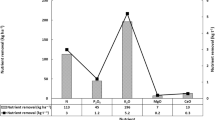Abstract
The phosphorus (P) requirement for grain production of different crop species (oats (Avena sativa), barley (Hordeum vulgare), triticale (xTriticosecale), narrow-leafed lupins (Lupinus angustifolius), and sandplain lupins (L. cosentinii) was compared with wheat (Triticum aestivum) in five field experiments on different lateritic soils in south-western Australia. Seven or eight levels of superphosphate were applied at the start of each experiment. The amount of P required to produce 70% (four experiments) or 90% (one experiment) of the maximum yield was used to compare P requirements. Large differences in the P requirements of the species were obtained.
On P deficient soil in 3 experiments, oats required from 50 to 70% less P than wheat, but required 40% more P on a soil with a long history of superphosphate applications.
Compared with wheat, in the year of P application, barley required 50% less P in one experiment, had similar P requirements in two experiments, and required 80% more P in another experiment. In the years after P application, barley required 20% less P in two experiments.
On an acidic soil triticale required from 50% to 70% less P than wheat, but on less acidic soil it required 100% more P.
In the year of P application, narrow-leafed lupins required 800% more P than wheat in one experiment, and 30% more P in the other experiment.
In the year of P application, sandplain lupins required 70% less P than wheat in one experiment.
Similar content being viewed by others
References
AOAC (1975) ‘Official Methods of Analysis’ 12 edn Assoc of Anal Chem: Washington DC
Black CA and Scott CO (1956) Fertilizer evaluation. I. Fundamental principles. Soil Sci Soc Am Proc 20: 176–179
Bowden JW and Bennett D (1976) The ‘Decide’ model for predicting superphosphate requirements. Proceeding of Phosphorus in Agriculture Symposium 1974. pp 6.1–6.36. Aust Instit Agric Sci: Parkville, Victoria
Colwell JD (1963) The estimation of phosphorus fertilizer requirements of wheat in southern New South Wales by soil analysis. Aust J Exp Agric Anim Husb 3: 190–197
Cotterill PJ and Sivasithamparam K (1988) The reduction of take-all by rotation with lupins, oats or field peas. J Phytopath 121: 125–134
Northcote KH (1979) ‘A Factual Key for the Recognition of Australian Soils’, 4th Edn. Rellim Tech Publ: Glenside, South Australia
Ozanne PG, Howes KMW and Petch A (1976) The comparative phosphate requirements of four annual pastures and two crops. Aust J Agric Res 27: 479–488
Ozanne PG and Petch A (1978) Effect of species and cultivation in the responses to phosphate of annual pastures and crops. Aust J Agric Res 29: 225–333
Ozanne PG and Shaw TC (1967) Phosphate sorption by soils as a measure of the phosphate requirement for pasture growth. Aust J Agric Res 27: 225–233
Rahman MS and Gladstones JS (1974) Differences amongLupinus species in field response to superphosphate. Aust J Exp Agric Anim Husb 14: 214–223.
Robson AD and Gilkes RJ (1980) Fertilizer responses (N, P, K, S, micronutrients) on lateritic soils in southwestern Australia — a review. Int Seminar on Laterilization Processes pp. 381–390 Oxford and IBM Publishing Co
Smith AN (1983) Australian dependence on phosphorusIn Eds AB Costin and CH Williams ‘Phosphorus in Australia’ Ch 3 pp. 75–91. Aust Nat Univ: Canberra, Australia
Sweetingham M (1990) Coping with brown spot and root rots of lupins. J Agric West Aust 31 (4th Series): 5–13
van Burg PFJ (1963) The agricultural evaluation of nitrophosphates with particular reference to the direct and cumulative phosphate effects, and the interaction between water solubility and granule size. The Fert Soc Proc No 75
Walkley A and Black IA (1934) An examination of the Degtjareff method of determining soil organic matter and a modification of the chromic and titration method. Soil Sci 37: 29–38
Wild A (1958) The phosphate content of Australian soils. Aust J Agric Res 9: 193–204
Yuen SH and Pollard AG (1954) Determination of nitrogen in agriculatural materials by the Nessler reagents. II. Microdeterminations in plant tissue and soil extracts. J Sci Food Agric 5: 364–369
Author information
Authors and Affiliations
Rights and permissions
About this article
Cite this article
Bolland, M.D.A. The phosphorus requirement of different crop species compared with wheat on lateritic soils. Fertilizer Research 32, 27–36 (1992). https://doi.org/10.1007/BF01054391
Received:
Accepted:
Issue Date:
DOI: https://doi.org/10.1007/BF01054391




